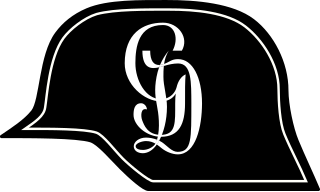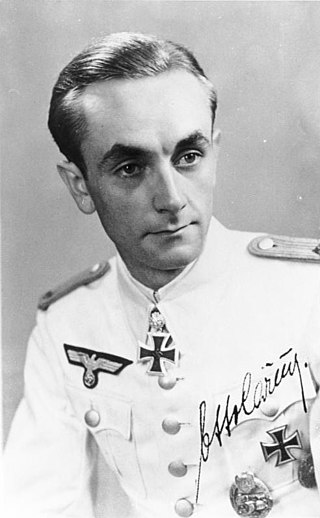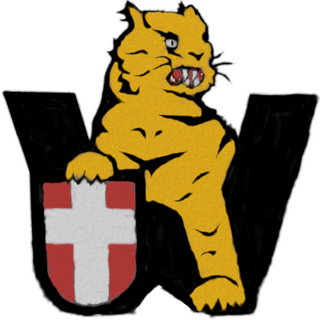
Michael Wittmann was a German Waffen-SS tank commander during the Second World War. He is known for his ambush of elements of the British 7th Armoured Division during the Battle of Villers-Bocage on 13 June 1944. While in command of a Tiger I tank, Wittmann destroyed up to 14 tanks, 15 personnel carriers and two anti-tank guns within 15 minutes before the loss of his own tank.

The Tiger II was a German heavy tank of the Second World War. The final official German designation was Panzerkampfwagen Tiger Ausf. B, often shortened to Tiger B. The ordnance inventory designation was Sd.Kfz. 182.. It was also known informally as the Königstiger. Contemporaneous Allied soldiers often called it the King Tiger or Royal Tiger.

The Panzergrenadier Division "Großdeutschland", also commonly referred to simply as Großdeutschland or Großdeutschland Division, was an elite combat unit of the German Army that fought on the Eastern Front in World War II.

The SS Division Hitlerjugend or 12th SS Panzer Division "Hitlerjugend" was a German armoured division of the Waffen-SS during World War II. The majority of its junior enlisted men were drawn from members of the Hitler Youth, while the senior NCOs and officers were from other Waffen-SS divisions. Most of the enlisted men were teenagers, starting from the ages of 16 or even 15.
101st Heavy SS Panzer Battalion was a German heavy tank battalion in the Waffen-SS during World War II. With the introduction of new Tiger II tanks in late 1944, the unit was renumbered as the 501st Heavy SS Panzer Battalion.

The 9th Panzer Division was a panzer division of the German Army during World War II. It came into existence after 4th Light Division was reorganized in January 1940. The division was headquartered in Vienna, in the German military district Wehrkreis XVII.

The 9th SS Panzer Division "Hohenstaufen" was a Waffen-SS armoured division of Nazi Germany during World War II. It participated in battles on both the Eastern and Western Fronts. The division was activated in December 1942. Many of the men of the division were young German conscripts, with a cadre of NCOs and staff from the SS Division Leibstandarte and other Waffen SS divisions. Hohenstaufen took part in the relief of German forces in the Kamenets-Podolsky pocket, the Normandy battles, Operation Market Garden, the Ardennes Offensive and Operation Spring Awakening. The division surrendered to the United States Army on 8 May 1945, at Steyr.
The 503rd Heavy Panzer Battalion was a German heavy Panzer Abteilung equipped with Tiger I and Panzer III tanks. In 1944, it was re-equipped with the new Tiger II. The battalion saw action on the Eastern and Western Fronts during World War II. As with other German heavy tank battalions, it was normally not assigned to a single corps, but shuffled around according to war circumstances. Later the battalion became part of the newly formed Panzer Corps Feldherrnhalle as the Feldherrnhalle Heavy Tank Battalion.

Otto Carius was a German tank commander in the Wehrmacht during World War II. He fought on the Eastern Front in 1943 and 1944 and on the Western Front in 1945. Carius is considered a "panzer ace", some sources credited him with destroying more than 150 enemy tanks, although Carius, in an interview claims he had around 100 kills or less. This was also due to the fact that he did not count kills as a commander, and rather only as a gunner. He was a recipient of the Knight's Cross of the Iron Cross with Oak Leaves.

A German heavy tank battalion was a battalion-sized World War II tank unit of the German Army (1935–1945), equipped with Tiger I, and later Tiger II, heavy tanks. Originally intended to fight on the offensive during breakthrough operations, the German late-war realities required it to be used in a defensive posture by providing heavy fire support and counter-attacking enemy armored breakthroughs, often organised into ad hoc Kampfgruppen.

The 502nd Heavy Panzer Battalion was a German heavy tank battalion during World War II. The battalion was the first unit to receive and field the Tiger I. It fought on the Eastern front. It was one of the most successful German heavy tank battalions, claiming the destruction of 1,400 tanks and 2,000 guns. Otto Carius, one of the best German tank aces, was a member.
The 501st Heavy Panzer Battalion was a German heavy Panzer Abteilung equipped with heavy tanks. The battalion was the second unit to receive and use the Tiger I heavy tank, changing to Tiger IIs in mid-1944.
The 508th Heavy Panzer Battalion was a German heavy Panzer Abteilung, during World War II, equipped with heavy tanks. It fought at Anzio and later defended German-held Northern Italy opposing the Allies during the Italian Campaign. It fought in Italy until it surrendered at the end of the war in May 1945.
This is the order of battle for Operation Epsom, a Second World War battle between British and German forces in Normandy, France between 26 June and 30 June 1944.
The V SS Mountain Corps was a Waffen-SS formation that existed in the later periods of World War II. The corps fought against the Yugoslav Partisans in the Balkans as part of the 2nd Panzer Army from October 1943 to December 1944. At this time it rarely had more than two understrength divisions. In 1945, the corps fought on the Oder line as part of the 9th Army, in the Frankfurt (Oder) area, and in the Battle of Berlin that followed.
103rd Heavy SS Panzer Battalion was a German heavy tank battalion of the Waffen-SS during World War II.
Panzer Division Tatra was an armored division of the German Heer formed in Moravia in August 1944. The division was hastily formed during the Slovak National Uprising of 1944 when the Germans feared that Slovakia might break away from the Axis powers and open the way for the advancing Red Army. After a brief punitive expedition against the Slovaks, the division was converted into a training formation. In March 1945, it was reorganized into the 232nd Panzer Division and was lost fighting in western Hungary.
The 85th Infantry Division was a Wehrmacht division used in the Second World War. It participated in the German defence in the Battle of Normandy, and took part in the German counter-offensive in the Ardennes.

Heinz von Westernhagen was a SS-Obersturmbannführer in the Waffen-SS during World War II. He was a member of the Leibstandarte SS Adolf Hitler (LSSAH) and commander of the 501st (101st) SS Heavy Panzer Battalion.

The 506th Heavy Panzer Battalion was a german heavy Panzer Abteilung equipped with Tiger I tanks until 28 July 1944. During the period from 20 August to 12 September 1944, it was re-equipped with a full complement of 45 Tiger Ausf. B tanks. Some of the first Tiger IIs delivered to the 506th were examples fitted with the early production turret. The battalion saw action on the Eastern and Western Fronts during World War II. As with other German heavy tank battalions, it was attached as needed to larger formations. The 506th was unique in being the only Tiger battalion to include a fourth company. German: schwere Panzerkompanie Hummel, equipped with Tiger I tanks, was consolidated with the 506th in 1944. It was also unique in that it regularly received new vehicles and replacements from other units to maintain a full complement. The unit served until the collapse of the Ruhr Pocket in April 1945, being officially disbanded by the battalion commander on 14 April. The unit performed well despite often poor conditions of deployment, officially credited with over 400 tank kills during its service with fewer than 75 combat losses.










